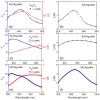Metal-Dielectric Nanopillar Antenna-Resonators for Efficient Collected Photon Rate from Silicon Carbide Color Centers
- PMID: 36616105
- PMCID: PMC9824870
- DOI: 10.3390/nano13010195
Metal-Dielectric Nanopillar Antenna-Resonators for Efficient Collected Photon Rate from Silicon Carbide Color Centers
Abstract
A yet unresolved challenge in developing quantum technologies based on color centres in high refractive index semiconductors is the efficient fluorescence enhancement of point defects in bulk materials. Optical resonators and antennas have been designed to provide directional emission, spontaneous emission rate enhancement and collection efficiency enhancement at the same time. While collection efficiency enhancement can be achieved by individual nanopillars or nanowires, fluorescent emission enhancement is achieved using nanoresonators or nanoantennas. In this work, we optimise the design of a metal-dielectric nanopillar-based antenna/resonator fabricated in a silicon carbide (SiC) substrate with integrated quantum emitters. Here we consider various color centres known in SiC such as silicon mono-vacancy and the carbon antisite vacancy pair, that show single photon emission and quantum sensing functionalities with optical electron spin read-out, respectively. We model the dipole emission fluorescence rate of these color centres into the metal-dielectric nanopillar hybrid antenna resonator using multi-polar electromagnetic scattering resonances and near-field plasmonic field enhancement and confinement. We calculate the fluorescence collected photon rate enhancement for these solid state vacancy-centers in SiC in these metal-dielectric nanopillar resonators, showing a trade-off effect between the collection efficiency and radiative Purcell factor enhancement. We obtained a collected photon rate enhancement from a silicon monovacancy vacancy center embedded in an optimised hybrid antenna-resonator two orders of magnitude larger compared to the case of the color centres in bulk material.
Keywords: Mie scattering; emission electromagnetic-dynamics; fluorescence collection enhancement; nanopillars; silicon carbide; single-photon sources; vacancy silicon.
Conflict of interest statement
The authors declare no conflict of interest.
Figures







References
-
- Awschalom D.D., Hanson R., Wrachtrup J., Zhou B.B. Quantum technologies with optically interfaced solid-state spins. Nat. Photonics. 2018;12:516–527. doi: 10.1038/s41566-018-0232-2. - DOI
-
- Atatüre M., Englund D., Vamivakas N., Lee S.Y., Wrachtrup J. Material platforms for spin-based photonic quantum technologies. Nat. Rev. Mater. 2018;3:38–51. doi: 10.1038/s41578-018-0008-9. - DOI
-
- Castelletto S., Boretti A. Silicon carbide color centers for quantum applications. J. Phys. Photonics. 2020;2:022001. doi: 10.1088/2515-7647/ab77a2. - DOI
-
- Ahmed N., Akhtar S., Inam F.A. Hyperbolic metamaterial-based metal–dielectric resonator-antenna designs for GHz photon collection rates from wide-range solid-state single-photon sources. J. Opt. Soc. Am. B. 2020;37:3469. doi: 10.1364/JOSAB.402890. - DOI
LinkOut - more resources
Full Text Sources

